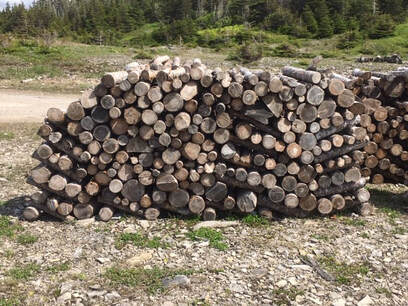Stacking Firewood for Efficiency
 The wetter the wood the more effort and energy there will have to go into the fire. Dry wood is essential to getting maximum heat from your fire. All combustion has water as a by product. All water in the wood or from combustion is converted to steam in the fire. The fire has to dry the wood before it will gasify and burn. Knowing how to properly store and stack your wood will serve you well in the long run whether you have a masonry heater or any other type of fireplace. Wood will not dry well with the bark intact so it needs to be split. For the best results, split down to approximately 3”-4” cross section. The best time to cut fire wood is in the fall or winter when the sap is down in the wood, then there is less moisture to have to dry out. The wood needs to be stacked off the ground and with a cover to keep the rain off of it. It also needs air movement through the sides of the pile to help it dry out. Two full years of air drying will allow the wood to reach optimum dryness of 15-20% moisture content. The dryer the better. Less moisture, more heat, less wood you will have to burn. The trouble with wood is moving and handling it. You want to work smart and move it the least amount of times possible. Our next blog post will go more in depth in how to store your wood. What You Need to Know About Having Your Chimney Cleaned
In order to safely and efficiently use your masonry heater or fireplace throughout the year, it is essential to hire a certified chimney sweep to clean your chimney. While a properly operated and maintained masonry heater or fireplace should produce minimal emissions and virtually no creosote, it is still important to regularly clean your chimney to ensure correct lighting and prevent potentially dangerous chimney fires. When using wood heat as the sole or primary method of heating your home, it is recommended to have your chimney inspected and cleaned every six months. For anyone that burns wood indoors at all, your chimney should be inspected and swept at least once a year.
Some products are advertised as providing a similar service to chimney sweeping but through the convenient medium of burning a special creosote sweeping log. While it is true that regularly burning these logs in a conventional fireplace can reduce the accumulation of creosote, they cannot replace a full inspection and cleaning by a certified professional. These logs are incapable of fully removing more hardened layers of creosote buildup in more severe cases, and an over-reliance on them can be dangerous. They should never be used in a masonry heater. Most importantly, certified chimney sweeps provide critical inspection for not only creosote buildup, but for the presence of any living or dead animals and any dangerous damage to the chimney lining or flue. In order to find a list of certified chimney sweeps near you, check out: http://www.csia.org/ 5 Important Tips for Storing Firewood:1. Make sure wood does not make direct contact with the ground 2. Keep wood away from moisture at all times 3. Store wood as close to your heater as possible 4. Stack wood in a well ventilated place 5. Enclose firewood so it is covered while maintaining air flow When deciding where to locate your heater, the placement of your outdoor and indoor wood storage areas should be taken into consideration. The paths from all wood storage areas to the heater should be as short as possible and involve no stairs. The outdoor area should be well-ventilated, dry, sheltered from rain and snow, and enclosed so the wood doesn't require repeated covering and uncovering. Just as you wouldn't go to the petroleum-products store to replenish the fuel every time the oil furnace kicks on, you'll want to move your firewood as infrequently as possible, in the largest possible loads, and as close to the heater as possible.
The main factors are that the wood is off the ground, rain cannot fall on it, there are walls or something to protect the sides, it is good to have as much air movement as possible, open on the front works well, it needs to be tall enough to get into without hitting your head, and you want to be able to store enough wood for two seasons and be able to get at the older wood that is driest when needed. About 4+ cords is what I would want. It can be very simple or complex. It can be open on two opposing sides for access on both sides. |
NEHS
At New England Hearth & Soapstone, we strive to spread the joy of heating with firewood. Archives
December 2020
Categories |
|
|
New England
Hearth & Soapstone Goshen, CT 860-491-3091 |
© 2020 New England Hearth & Soapstone
Website by Steers Studios
 RSS Feed
RSS Feed
